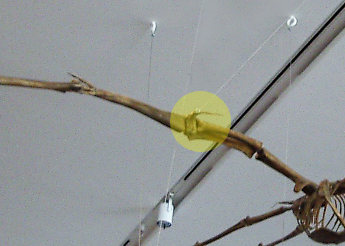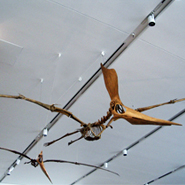Posted 10 December 2009
Flying dinosaur controversy resolved
New research appears to have ended a scientific debate that has vexed palaeontologists for almost 100 years.
Flying reptiles called pterosaurs ruled the Earth’s skies for over 130 million years and died out 65 million years ago.
The aerodynamics of the membrane stretched over the huge 12-meter wing span would have influenced the way these animals could fly, but scientists have not been able to agree on the orientation of a particular wing-bone that controlled the shape of this membrane.
Pictured far right: A pterosaur skeleton (photo by Saku Takakusaki)
Since 1914, there have been two theories on the positioning of the pteriod, a unique wing-bone at the front of the pterosaur wing. One argues that it must have been positioned sideways, while the other suggests that it pointed forwards.
Using biomechanical analysis and testing aerodynamic efficiency, new findings by researchers from the University of Bristol, UK, and University College Dublin, Ireland, suggest that the only conceivable positioning of the wing bone is a sideways orientation.
“Based on existing fossil evidence, pterosaurs are believed to have had a wing span of up to 12 metres and a weight of between 80 and 250 kilograms,” says Colin Palmer from the University of Bristol and lead author on the paper.
“In our analysis we show that a forward pointing pteriod would not have been able to withstand the stresses and strains involved in the take off and flight of such a large animal.”
“The structure of the pterosaur wing must have afforded a high safety margin above what was required to support flight in such a massive animal, in order to prevent against any possible breakage or damage which would be catastrophic for the animal. And a forward pointing pteriod would not afford such a safety margin,” explains Palmer.

Detail of pteroid bone on Pterosaur wing
“We were working to reconstruct how these enormous reptiles flew - how they took to the air, how they landed, and how they made their living in flight,” says Dr Gareth Dyke from UCD School of Biology & Environmental Science, the papers co-author.
“The direction of the pteriod bone has a major impact on the aerodynamics and performance of the pterosaur wing. A sideways orientation implies a faster flyer.”
“It affects the speed at which they could fly, which could tell you about the type of life they led, where they lived, and possibly even what they ate. They are the biggest animals ever take to the skies,” says Dyke.
The research is published online this week in the Proceedings of The Royal Society B.
(Produced by UCD University Relations)

